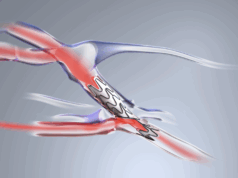 Saravanan Balamuthusamy (PPG Healthcare, Fort Worth, USA) writes to assess recent evidence on the contribution that can be made to vascular access for dialysis by machine learning algorithms, including prediction of reintervention and the mitigation of costs.
Saravanan Balamuthusamy (PPG Healthcare, Fort Worth, USA) writes to assess recent evidence on the contribution that can be made to vascular access for dialysis by machine learning algorithms, including prediction of reintervention and the mitigation of costs.
Predictive analytics with high levels of precision are in practice for weather forecasting every day, allowing 100,000 flights to take off and land safely all over the world, while financial forecasting models are established in the investment and banking community. Successfully developing similar mathematical models in healthcare is challenging, however, as the outcomes are driven by clinical variables which are hard to predict. Regression equations such as Framingham heart risk scores are well known within the medical community for risk assessment, but they lack real-time inputs, and cannot be precise to the risk portfolio of every patient. Machine learning is much more advanced than regression equations as it assimilates relevant data in real time which are also more pertinent to a single patient—or to a large cohort, as long as the outcomes are predefined.
Dialysis vascular access is a lifeline for haemodialysis patients until they get a kidney transplant. With better survival rates on dialysis, increasing kidney disease burden and fewer organs available for a kidney transplant, there is an increased need for the creation and maintenance of arteriovenous (AV) accesses that can withstand the test of time—that is, getting cannulated 312 times a year.1 Surveillance and monitoring technologies utilising wearables, needle reversal and transonics are highly focused on flow and pressure metrics to assess access function, but the upstream and downstream biological events that predispose a patient to access flow changes have already occurred before the clinician recognises that with screening and monitoring devices. A decrease in AV access flow is a pre-terminal event, hence there is a need for technology to identify patients who are at risk for developing upstream and downstream biological events that precipitate access flow compromise.2 Monitoring flow alone would be similar to a landing gear malfunction alarm at 30,000 feet as opposed to knowing the problem before takeoff.
Numerous factors including but not limited to age, sex, social determinants, ethnicity, comorbid conditions, lab parameters, genomics and anatomical dimensions determine why biological events occur in patients with AV accesses that lead to stenosis and, eventually, access failure. However, not all these variables have the same weight across all patients, and there is therefore a need for a precision medicine approach in dialysis vascular access. Application of precision medicine is often challenging due to scalability as workflows and data points (e.g. genomic lab tests) might not be available at all touchpoints of care.
Machine learning in medicine requires access to data sources like electronic medical records (EMR), claims and image data. Numerous variables like demographics, labs and image data can be obtained from the EMR and cost data can be abstracted from claims.3 Real-time information on access symptoms could be obtained from the patients if they use a mobile app geared towards access care. Wearables and flow surveillance devices would be helpful in identifying variations in flow and pressure in addition to recording vitals. However, an access biometric like flow could be just another variable, and it would not be sufficient in itself to predict emerging access dysfunction before damage occurs.
The application of machine learning in AV access could complement the end-stage kidney disease (ESKD) life plan recommended by the Kidney Disease Outcomes Quality Initiative (KDOQI).4 Predictive analytics utilising machine learning can have numerous applications in AV access. These include prediction of the likelihood of a successful AV fistula with an approximate maturation period, which would be time to cannulation. It may also help in identifying patients who might be candidates for successful endovascular AV fistula (endoAVF) creation, as well as in predicting patients for an early AV graft as opposed to “fistula first”. Predicting risk for access dysfunction due to inflow versus outflow issues is also a possibility, as is estimating the need for reintervention in patients with AV access stenosis. Lastly, it may help calculating the cost of AV access creation and maintenance at a patient and group level.
Cost is not a consequence in medicine—it is now an outcome based on which hospitals and physician groups are scored and paid. Therefore, understanding emerging risk of access dysfunction for maintaining and salvaging a patient’s lifeline alone is not sufficient; it is also essential to understand costs. We have recently published our outcomes on utilising machine learning analytics on predicting reinterventions, as well as its impact on AV access, utilising a data abstraction software (Plexus EMR) and machine learning analytics platform (OptMyCare Inc) to predict cost and outcomes in 200 patients. Treating physicians had visibility to the risk of reinterventions and the choice to use current standards of care including but not limited to stents, drug-coated balloons, flow reduction and other special balloons which they deemed fit for their scope of practice. Just like most other chronic conditions, 20% of the cohort contributed to over 50% of the cost in this study and there was a significant reduction in the need for thrombectomies, reinterventions and a US$1,000 cost reduction per patient per year after the machine learning analytics outputs were implemented.5
With increased scrutiny on cost and outcomes across value-based care entities in nephrology, there is an unmet and urgent need for utilising machine learning analytics in identifying the 20– 30% of high-risk patients and appropriately intervening on them to improve outcomes, as well as to decrease hospitalisations and the cumulative cost of care.
Acknowledgements: Soumya Gopalakrishnan and Ayala Siddique for assisting with draft.
References:
- El Nahas, AM, and Bello, AK. “Chronic kidney disease: the global challenge.” The Lancet 9456 (2005): 331-340.
- Feldman, HI, et al; “Hemodialysis vascular access morbidity in the United States.” Kidney International5 (1993): 1091-1096. Health Care Financing Research Report, End-Stage Renal Disease, 1989. Department of Health and Human Services, Health
- Kordzadeh, A, and Esfahlani, SS. “The role of artificial intelligence in the prediction of functional maturation of arteriovenous fistula.” Annals of Vascular Diseases (2019): oa-18
- Lok CE, Huber TS, Lee T, et al; KDOQI Vascular Access Guideline Work Group. KDOQI clinical practice guideline for vascular access: 2019 update. Am J Kidney Dis. 2020;75(4)(suppl 2):S1-S164.
- Balamuthusamy S, Dhanabalsamy N, Thankavel B, Bala MS, et al; Utility of a ML analytics on real time risk stratification and re-intervention risk prediction on AV access outcomes and cost. The Journal of Vascular Access. 2023. https://doi.org/10.1177/1129729823115663.










